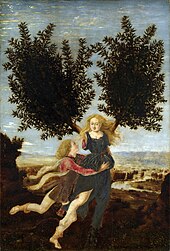Daphne: Difference between revisions
another example |
Reverted 1 edit by 75.87.129.242 (talk): Spam. (TW) |
||
| Line 27: | Line 27: | ||
* [http://www.theoi.com/Nymphe/NympheDaphne.html Theoi Project: Daphne] |
* [http://www.theoi.com/Nymphe/NympheDaphne.html Theoi Project: Daphne] |
||
* [http://digilander.libero.it/debibliotheca/Arte/bernini/bernini_apollo_and_daphne.jpg Apollo and Daphne] – statue by [[Gian Lorenzo Bernini]] |
* [http://digilander.libero.it/debibliotheca/Arte/bernini/bernini_apollo_and_daphne.jpg Apollo and Daphne] – statue by [[Gian Lorenzo Bernini]] |
||
* [http://www.goodrichpaintings.com/paintings/2000s/07.htm painting by David Goodrich] |
|||
[[Category:Dryads]] |
[[Category:Dryads]] |
||
Revision as of 22:53, 5 March 2012



Daphne (/[invalid input: 'icon']ˈdæfniː/; Greek: Δάφνη, meaning "laurel") was a female minor nature deity. Pursued by Apollo, she fled and was chased. Daphne begged the gods for help, who then transformed her into Laurel.
Overview
According to Greek myth, Apollo chased the nymph Daphne, daughter either of Peneus and Creusa in Thessaly,[1] or of the river Ladon in Arcadia.[2] The pursuit of a local nymph by an Olympian god, part of the archaic adjustment of religious cult in Greece, was given an arch anecdotal turn in Ovid's Metamorphoses,[3] where the god's infatuation was caused by an arrow from Eros, who wanted to make Apollo pay for making fun of his archery skills and to demonstrate the power of love's arrow. Ovid treats the encounter, Apollo's lapse of majesty, in the mode of elegiac lovers,[4] and expands the pursuit into a series of speeches. According to the rendering Daphne prays for help either to the river god Peneus or to Gaia, and is transformed into a laurel (Laurus nobilis): "a heavy numbness seized her limbs, thin bark closed over her breasts, her hair turned into leaves, her arms into branches, her feet so swift a moment ago stuck fast in slow-growing roots, her face was lost in the canopy. Only her shining beauty was left."[5] "Why should she wish to escape? Because she is Artemis Daphnaia, the god's sister," observed the Freudian anthropologist Géza Róheim,[6] and Joseph Fontenrose concurs;[7] boldly stating such a one-to-one identity doubtless oversimplifies the picture: "the equation of Artemis and Daphne in the transformation myth itself clearly cannot work", observes Lightfoot.[8] The laurel became sacred to Apollo, and crowned the victors at the Pythian Games.[9] Most artistic impressions of the myth focus on the moment of transformation.
A version of the attempt on Daphne's sworn virginity that has been less familiar since the Renaissance was narrated by the Hellenistic poet Parthenius, in his Erotica Pathemata, "The Sorrows of Love".[10] Parthenius' tale, based on the Hellenistic historian Phylarchus, was known to Pausanias, who recounted it in his Description of Greece (2nd century AD).[11] In this, which is the earliest written account, Daphne is a mortal (person) girl fond of hunting and determined to remain a virgin; she is pursued by the lad Leucippos ("white stallion"), who assumes girl's outfits in order to join her band of huntresses. He is so successful in gaining her innocent affection, that Apollo is jealous and puts it into the girl's mind to stop to bathe in the river Ladon; there, as all strip naked, the ruse is revealed, as in the myth of Callisto, and the huntresses plunge their spears into Leucippos. At this moment Apollo's attention becomes engaged, and he begins his own pursuit; Parthenius' modern editor remarks on the rather awkward transition, linking two narratives.[12]
A famous rendition of the subject is Gian Lorenzo Bernini's sculpture Apollo and Daphne. In music, the German composer Richard Strauss composed a one-act opera about the legend based on accounts by both Ovid and Euripides.
Artemis Daphnaia
Artemis Daphnaia, who had her temple among the Lacedemonians, at a place called Hypsoi[13] in Antiquity, on the slopes of Mount Cnacadion near the Spartan frontier,[14] had her own sacred laurel trees.[15]
Temple of Apollo Daphnephoros, Eretria
At Eretria the identity of an excavated 7th and 6th century temple[16] to Apollo Daphnephoros, "Apollo, laurel-bearer", or "carrying off Daphne", a "place where the citizens are to take the oath", is identified in inscriptions.[17]
Notes
- ^ Hyginus Fabulae 203.
- ^ Pausanias viii.20.1 and x.7.8; Statius, Thebaid iv.289f; Johannes Tzetzes Ad Lycophron 6; Philostratus, Life of Apollonius of Tyana i. 16; First Vatican Mythographer ii.216; none of these citations are earlier than Parthenius' source Phylarchus.
- ^ Ovid, Metamorphoses i. 452; the treatment is commonly viewed as an Ovidian invention: see H. Fränkel, Ovid: A Poet Between Two Worlds (1945) p 79, or E. Doblhofer, ""Ovidius Urbanus: eine Studie zum Humor in Ovids Metamorphosen" Philologus 104 (1960), p. 79ff; for the episode as a witty transposition of Calvus' Io, see B. Otis, Ovid as an Epic Poet 2nd ed. 1970, p. 102
- ^ W.S.M. Nicoll, "Cupid, Apollo, and Daphne (Ovid, Met. 1. 452 ff.)" The Classical Quarterly, New Series, 30.1 (1980; 174–182).
- ^ Translation by A. S. Kline, 2000.
- ^ Róheim, Animism, Magic and the Divine King, (London 1930:308)
- ^ Fontenrose, The Delphic oracle: its responses and operations 1981:49.
- ^ lightfoot p. 474.
- ^ Pausanias, x.7.8.
- ^ J. L. Lightfoot, tr. Parthenius of Nicaea: the poetical fragments and the Erōtika pathēmata 1999, notes to XV, Περὶ Δάφνης pp 471ff.
- ^ Pausanias viii.20.2.
- ^ Lightfoot, p. 471.
- ^ G. Shipley, "The Extent of Spartan Territory in the Late Classical and Hellenistic Periods", The Annual of the British School at Athens, 2000.
- ^ Pausanias, 3.24.8 (on-line text); Lilius Gregorius Gyraldus , Historiae Deorum Gentilium, Basel, 1548, Syntagma 10, is noted in this connection in Benjamin Hederich, Gründliches mythologisches Lexikon, 1770
- ^ Karl Kerenyi, The Gods of the Greeks, 1951:141
- ^ Built over 8th century walls and apsidal building beneath the naos, all betokening a Geometric date for the sanctuary.
- ^ Rufus B. Richardson, "A Temple in Eretria" The American Journal of Archaeology and of the History of the Fine Arts, 10.3 (July - September 1895:326-337); Paul Auberson, Eretria. Fouilles et Recherches I, Temple d'Apollon Daphnéphoros, Architecture (Bern, 1968). See also Plutarch, Pythian Oracle, 16.
